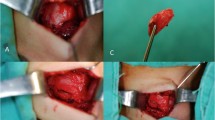Abstract
The goal of this pilot study was to test vocal fold medialization using autologous tragal cartilage and perichondrium by direct approach for treating high vagal paralysis. Five patients with the skull base tumors with involvement of the vagus nerve underwent concurrent vocal fold medialization with surgical excision. The patients were evaluated preoperatively, and at 14, 60 days, and 6 months later. Complete medialization with horizontal and vertical realignment was achieved. Improvement of voice and breathiness was correlated with the increase of closed quotient; the contact area of the vocal fold mucosa has increased. This advancement reduces breathiness and induced an improvement in subglottic pressure with aerodynamic parameters improvement, which led to stabilization of the vocal fold oscillation and a better voice quality recovery. This method can be considered a safe, quick, and efficient phonosurgical procedure combined with a skull-base surgical procedure.





Similar content being viewed by others
References
Mesallam TA, Khalil YA, Malki KH, Farahat M (2011) Medialization thyroplasty using autologous nasal septal cartilage for treating unilateral vocal fold paralysis. Clin Exp Otorhinolaryngol 4(3):142–148
Koufman J (1986) Laryngoplasty for vocal cord medialization: an alternative to teflon. Laryngoscope 96(5):726–731
Morgan JE, Zraick RI, Griffin AW, Bowen TL, Johnson FL (2007) Injection versus medialization laryngoplasty for treatment of unilateral vocal fold paralysis. Laryngoscope 117(11):2068–2074
Crumley RL (1990) Teflon versus thyroplasty versus nerve transfer: a comparison. Ann Otol Rhinol Laryngol 99(10 pt 1):759–763
Woo P, Pearl AW, Hsiung MW, Som P (2001) Failed medialization laryngoplasty: management by revision surgery. Otolaryngol Head Neck Surg 124(6):615–621
Tucker HM (1993) Simultaneous medialization and reinnervation for unilateral vocal fold paralysis. Oper Tech Otolaryngol-Head Neck Surg 4(3):183–185
Tucker HM (1999) Long-term preservation of voice improvement following surgical medialization and reinnervation for unilateral vocal fold paralysis. J Voice 13(2):251–256
Smith ME, Nelson R, Stoddard K (2008) Ansa-RLN reinnervation for unilateral vocal fold paralysis in adolescents and young adults. Inter J Pediat Otorhinolaryngol 72(6):1311–1316
Isshiki N, Morita H, Okamura H, Hiramoto M (1974) Thyroplasty as a new phonosurgical technique. Acta Otolaryngol 78(5–6):451–457
Choi HS, Chung SM, Lim JY, Kim HS (2008) Increasing the closed quotient improves voice quality after type I thyroplasty in patients with unilateral vocal cord paralysis: analysis using SPEAD program. J Voice 22(6):751–755
Bihari A, Mészaros K, Remenyi A, Lichtenberger G (2006) Voice quality improvement after management of unilateral vocal cord paralysis with different techniques. Eur Arch Otorhinolaryngol 263(12):1115–1120
Thakar A, Sikka K, Verma R, Preetam C (2011) Cricothyroid approximation for voice and swallowing rehabilitation of high vagal paralysis secondary to skull base neoplasm. Eur Arch Otorhinolaryngol 268:1611–1616
Amir O, Ashkenazi O, Leibovitzh T, Michael O, Tavor Y, Wolf M (2006) Applying the Voice Handicap Index (VHI) to dysphonic and nondysphonic Hebrew speakers. J Voice 20(2):318–324
Remacle M, Friedrich G, Dikkers FG, De Jong F (2003) Phonosurgery of the vocal folds: a classification proposal. Eur Arch Otorhinolaryngol 260(1):1–6
Friedrich G, Remacle M, Birchall M, Marie JP, Arens C (2007) Defining phonosurgery: a proposal for classification and nomenclature by the Phonosurgery Committee of the European Laryngological Society (ELS). Eur Arch Otorhinolaryngol 264(10):1191–1200
Hoffman MR, Witt RE, Chapin WJ, McCulloch TM, Jiang JJ (2010) Multi-parameter comparison of injection laryngoplasty, medialization laryngoplasty, and arytenoids adduction in an excised larynx model. Laryngoscope 120(4):769–776
Arens C, Remacle M (2010) Scarred larynx. In: Remacle M, Eckel H (eds) Surgery of the larynx and trachea, 1st edn. Springer, Berlin, pp 71–176
Acknowledgments
This work was supported by a grant of “Iuliu Haţieganu” University of Medicine and Pharmacy Cluj-Napoca.
Author information
Authors and Affiliations
Corresponding author
Rights and permissions
About this article
Cite this article
Chirilă, M., Mureşan, R. Vocal fold medialization with tragal cartilage and perichondrium in high vagal paralysis. Eur Arch Otorhinolaryngol 270, 1873–1878 (2013). https://doi.org/10.1007/s00405-013-2427-y
Received:
Accepted:
Published:
Issue Date:
DOI: https://doi.org/10.1007/s00405-013-2427-y




